A story…
It was around 1979-80, I had already graduated from college, with an art degree, where I sort of learned to weave, and I had by this point purchased my first loom. I had a little money from a deceased grandmother and I used it to get as much loom as I could afford, and after some recommendations and a little research, I purchased my Tools of the Trade. I got lots of extras, like a second warp beam and sectional beams, equipment I really didn’t know anything about, but I figured I’d grow into this thing. It was big. 45″ wide with 8 shafts. I was gainfully employed working for The Craft Showcase in the Paramus Park Mall, teaching craft classes and doing window displays, mostly involving the fiber technique of the decade, Macramé.
On the advice of my high school art teacher, whom I ran into in a shoe store, I joined NJ Designer Craftsmen, a state wide organization of craftsmen, all media, and quickly got involved. It was in an issue of their newsletter that I found an ad for a couple of designers looking for a production weaver. I really didn’t know what production weaver meant, but I had a loom, so that made me a weaver, and I really really wanted out of my job working at the mall, I loved the teaching but retail corporate America was tough for me to function in, decisions were made for profit only and no one ever talked to the actual employees or worse, the customers. Sound familiar?
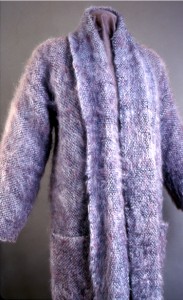 Anyway, this pair of designers needed weavers to weave their production mohair yardage, we connected, and I learned quick. I wove yardage, usually about 30 yards at a time, some throws, many shawls, and occasionally, when they found out I could sew, I made garments. Simple loom shaped, but that was the style back in the late 70’s early 80’s. I actually acquired one of the coats I made for them, but there are little records or images to show the hundreds of yards, and I mean hundreds and hundreds of yards I wove over a couple of years. It was a good early job for me, and one that cemented my efficiency on the loom, how to get on and off quickly, and actually earn a meager living.
Anyway, this pair of designers needed weavers to weave their production mohair yardage, we connected, and I learned quick. I wove yardage, usually about 30 yards at a time, some throws, many shawls, and occasionally, when they found out I could sew, I made garments. Simple loom shaped, but that was the style back in the late 70’s early 80’s. I actually acquired one of the coats I made for them, but there are little records or images to show the hundreds of yards, and I mean hundreds and hundreds of yards I wove over a couple of years. It was a good early job for me, and one that cemented my efficiency on the loom, how to get on and off quickly, and actually earn a meager living.
The original specifications for this yardage made for some of the speed in weaving it, 6epi, using a 6 dent reed, and the weft was usually a serendipitous selection of mixed mohairs, two per pick, four picks to the inch. The only thing that slowed me down was constantly changing the shuttle bobbins. I loved weaving the solid fabrics, though they were boring. Many years later, my experience tells me that the specs for this yardage aren’t the best or the sturdiest for garment construction, as a matter of fact, it was quite common to poke one’s finger through the structure. The yarns were loosely held into place by brushing the surface of the cloth while still on the loom under tension. The surface fur sort of kept everything connected. The end result was luxurious and I had mohair hair everywhere! That and the fact that I had a couple of long haired dogs at the time, I can’t imagine I ate a meal where I wasn’t picking airborne fuzz out of my food! The studio in our apartment was right off the kitchen.
I ended my relationship with this pair of designers sometime in the early 1980’s, largely because if I didn’t, I’d never weave again. The last commission I worked on, was 90 mohair shawls, and I think I managed to produce about 60 before I looked at my loom and said, “I can’t do this anymore.” I found another eager weaver, and turned the remainder of the commission over to her, but that was all so very long ago, and the rest is sort of history.

 I did craft fairs for about 10 years, selling my handwoven garments, and it was a number of years before I reintroduced mohair into the equation. For obvious reasons. Here I used it in my production fabrics as the weft, 15 yards of a 30 yard mixed warp would be woven with a rayon/silk weft, and 15 yards would be woven with mohair. So the fabrics would coordinate. I got pretty good at this mix, and at my peak, I could knock out a yard of fabric, 45″ wide, in 11 minutes. But I was young then and it was all so very long ago…
I did craft fairs for about 10 years, selling my handwoven garments, and it was a number of years before I reintroduced mohair into the equation. For obvious reasons. Here I used it in my production fabrics as the weft, 15 yards of a 30 yard mixed warp would be woven with a rayon/silk weft, and 15 yards would be woven with mohair. So the fabrics would coordinate. I got pretty good at this mix, and at my peak, I could knock out a yard of fabric, 45″ wide, in 11 minutes. But I was young then and it was all so very long ago…
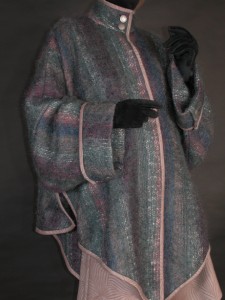
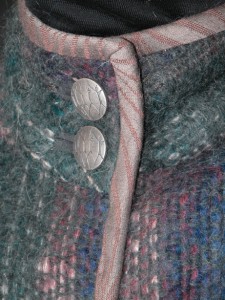 Back in 2003, I revisited this structure, since I still had a lot of mohair on the shelves from my craft fair days, but instead of constantly changing wefts, I decided to turn the structure, setting it at 8epi, two ends in a four dent reed, and weaving in a sort of basket structure, single shuttle weft over two and under two warps, at 6 picks per inch. It worked fine, and I got warp striping instead of blocks of weft color, which are impossible to match on side seams and such.
Back in 2003, I revisited this structure, since I still had a lot of mohair on the shelves from my craft fair days, but instead of constantly changing wefts, I decided to turn the structure, setting it at 8epi, two ends in a four dent reed, and weaving in a sort of basket structure, single shuttle weft over two and under two warps, at 6 picks per inch. It worked fine, and I got warp striping instead of blocks of weft color, which are impossible to match on side seams and such.
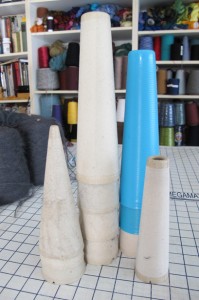 I made this lovely cape, which incidentally I sold at the guild show and sale last month, and the fabric worked well for this application, but I really wanted a structure with more meat. So this brings me up to my last blog post, where I decided to do some serious stash busting in an attempt to load all seven of my Tools of the Trade looms with various projects, something I’ve never had happen before, and I’m not sure why this is important to me, but I want something to come back to at the end of February when I finish my month long teaching adventure in California, and that’s a good enough reason. Plus I’m appalled at how my stash never gets reduced, only reproduces, and this is not a good thing.
I made this lovely cape, which incidentally I sold at the guild show and sale last month, and the fabric worked well for this application, but I really wanted a structure with more meat. So this brings me up to my last blog post, where I decided to do some serious stash busting in an attempt to load all seven of my Tools of the Trade looms with various projects, something I’ve never had happen before, and I’m not sure why this is important to me, but I want something to come back to at the end of February when I finish my month long teaching adventure in California, and that’s a good enough reason. Plus I’m appalled at how my stash never gets reduced, only reproduces, and this is not a good thing.
I finished winding all the 2″ bouts of warp, and tied them onto the front beam of the loom.
I sleyed the reed. 2 per dent in a 5 dent reed. I really debated here, and finally, at the last minute, knowing I was taking a big risk, decided to go for 10 epi, because I wanted a slightly warp faced surface.
I threaded the heddles.
I tied onto the lash cords coming up from my sectional beam. This loom was equipped with one and I usually keep it on, even when warping with warp chains, so I can avoid packing material.
And so I started beaming. I did not use any lease sticks for tensioning, this warp was way too sticky to pass easily through them, and there was enough drag to tension, even onto a sectional beam.
I’d carefully comb out each bout, separating the two layers in the reed, and then pull hard on each bout to create firm packing on the warp beam.
It was here I discovered a skipped dent. Damn…
I frequently cleared the accumulated fluff that jammed up the reed.
I keep large cable ties on each of my back beams, that I slide into place to create a fence to keep yarns from hoping the pegs. I do the same thing when I wind with paper on a plain warp beam.
And once beamed, I corrected the skipped dent, and tied onto the front. Yes, this warp is sticky. Yes, the stickiness is manageable. Largely to weave mohair, especially at 10 epi, you need a couple of things, a direct tie up, that is one shaft to one treadle, you need a sturdy loom, that is stronger than the sticky warp, and I found that fixed shafts that ride up and down in tracks work better than floating shafts like on a Macomber or Harrisville. I treadle the first shaft followed by the third for plain weave. Lifting 25% of the warp at a time, vs. trying to separate 50/50 is infinitely easier. I’m thinking that a countermarche loom would work best for trying to separate sticky warps, but I don’t have one and have no interest in getting one, so what I have is what I have and I’m making it work. Incidentally, this loom is my original TOTT loom from 1978. It has never failed me. Hence the start of my love affair with TOTT looms. I’m still looking for a TOTT 12 shaft table loom, if anyone is willing to part with theirs. Art made a few, and I know they exist, and I’d love to add one to my collection.
Just a few additional hints on working with mohair. You need a big boat shuttle. I mean BIG! Leclerc makes one with a 6″ bobbin. Otherwise you are reloading the bobbins about every three or four passes of the shuttle. And I trim the fuzz off each end of the bobbin before I load it. Front end feed shuttles will clog pretty quickly with the mohair fuzz.
And so I am weaving on this yardage, I’m happy with plain weave, the structure is sturdier, and before I advance the cloth, I brush the pile up on the surface with a sweater brush, this one is from the 80’s, and it still works fine. I am really really happy with how it looks, and that’s a good thing because I’ve got 12 yards of warp ahead of me…
I do teach an online class through weavolution.com in warping from front to back. New class dates for January are coming soon. Stay tuned…
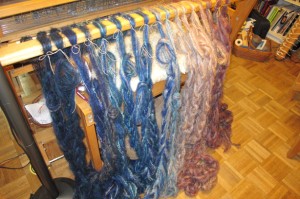
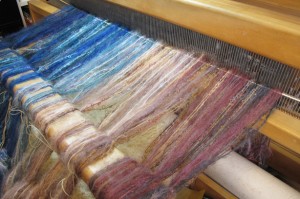
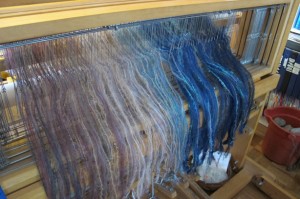
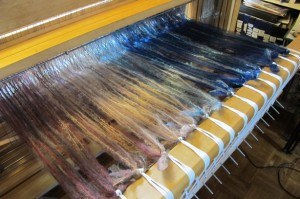
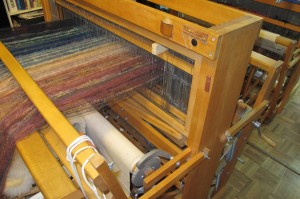
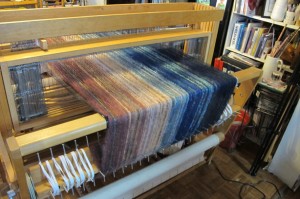
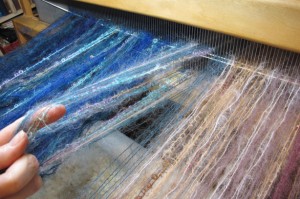
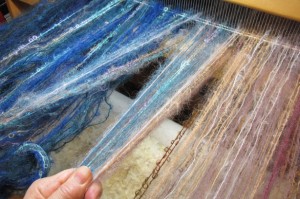
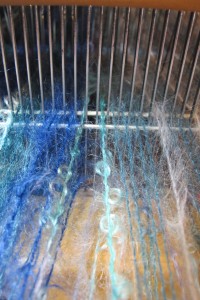
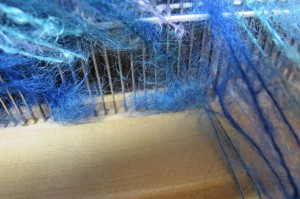
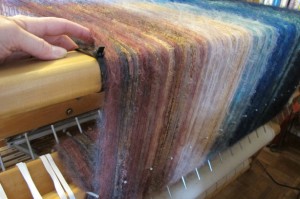
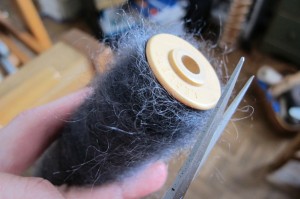
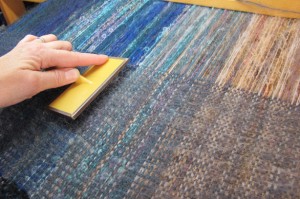
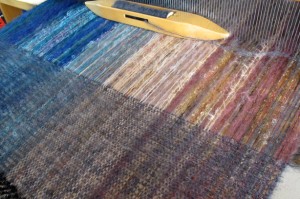
I love the way the colors blend together. Your sweater brush looks a lot like the brush I got for my cat!
‘fascinating” which means I will be re-reading this 🙂 I usually weave with linen, cottolin and chenille, crazy I know. ONE day I will try wool and then mohair. Although I did weave 25 scarves with very mixed warps on a table loom, my TOTT loom and they were successful so there is hope!! Your warp is lovely, GO Daryl!!
Just stunning!
What a great blog post this time. I took three classes of yours and I will tell one one thing I will be back for more. I read everyone of your blogs as they come over my phone. I hope you have a great Xmas and your family will be home. Please keep posting I love to read them and it gets me moving on my loom. Ted wizorek
What a terrific piece of teaching this blog is, photos included. This is one I keep in my own e-stash for frequent reference. Beautiful fabric, precise information and inspirational! Thanks! (How do you keep doing this?)
Thanks for the post. I have a large stash of Patons Divine which I’m not afraid of busting out now. (hi neighbor, I’m from frances irwin)